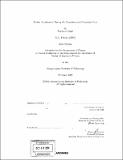Protein localization during the cyanobacterial circadian cycle
Author(s)
Luitel, Prashant
DownloadFull printable version (20.88Mb)
Other Contributors
Massachusetts Institute of Technology. Dept. of Physics.
Advisor
Alexander van Oudenaarden.
Terms of use
Metadata
Show full item recordAbstract
Circadian clocks are ubiquitous throughout the living world. Of these circadian clocks, the simplest one is found in cyanobacteria - unicellular, photosynthetic marine organisms. Studies of the circadian clock of Synechococcus Elongatus PCC 7942 have shown that the circadian clock is independent of genetic transcription and depends only upon the interactions between three proteins - KaiA, KaiB, and KaiC. As such, the cyanobacterial circadian clock provides a unique opportunity to study complex dynamics that can result just from the interactions between three proteins and how the signal from this core oscillator is then subsequently used to drive other mechanisms in the cell. The purpose of this work was to study the circadian clock in vivo to try and understand their interactions in a living cell rather than in a test tube. When the proteins were tagged with yellow fluorescent protein (YFP) and the cells observed with a microscope, a curious phenomenon was observed. The three proteins were found to localize towards one of the poles of the cell when overexpressed. It was found that the localization of KaiA was dependent on the presence of KaiB and KaiC. Furthermore, it was found that the localization of KaiA was dependent on the specific phosphorylation state of KaiC, namely phosphorylation at the Ser431 site. It was found that the localization of KaiB was independent of KaiC or KaiA and that the localization did not show a preference for one of the poles (new vs. old). That the localization of one protein is dependent upon the phosphorylation state of another gives a strong indication that protein localization is a biologically relevant phenomenon - either in the functioning of the clock itself or some action of the clock on other systems. Experiments were carried out to investigate whether there was any time-dependent behaviour of localization during the circadian cycle but no such behaviour was ascertained. It was also discovered that overexpression of KaiA caused an inhibition of cell division which might be a mechanism by which cyanobacteria use the circadian clock to regulate cell division.
Description
Thesis (S.M.)--Massachusetts Institute of Technology, Dept. of Physics, 2008. Includes bibliographical references (p. 77-[78]).
Date issued
2008Department
Massachusetts Institute of Technology. Department of PhysicsPublisher
Massachusetts Institute of Technology
Keywords
Physics.